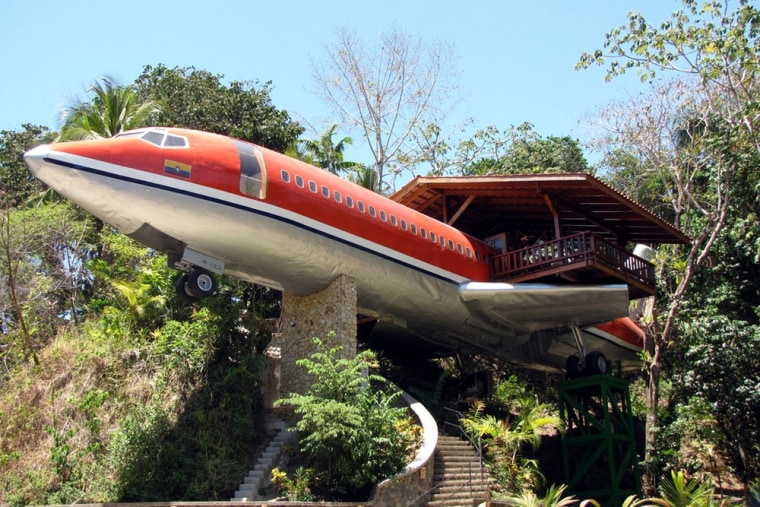Recycling is de rigeur, and no one wants to see a perfectly good historic property go to waste. That (and, of course, the marketing draw) is why you see so many hotels popping up in spaces once used for other purposes, whether primary school or prison. Someday, you might be heading off for a night's rest in a hotel that was once:
A jet-setting plane
Hotel Costa Verde in Costa Verde, Costa Rica, transported the shell of an old 1965 Boeing 727 and transported it to the jungle — making it look like it "landed" among the treetops. The result is part-hotel suite, part-treehouse. The now-teak interior is big enough for two bedrooms, a kitchenette and a dining area, and the spacious balcony offers a toucan's-eye-view of the jungle beyond. We know some travelers find it hard to sleep on planes, but we don't think anyone will have any trouble here.
A run-down paper factory
When the Lorenzo García family found the property that became A Quinta da Auga in Santiago de Compostela, Spain, it could hardly be called a former paper factory—the site was basically in ruins, with vegetation climbing over the 18th-century stone walls. The hotel today, now a Relais & Châteaux property, boasts 59 guest rooms in the old warehouse, with scenery of the river and aqueduct that once powered the paper mill.
A centuries-old fort
Emerging from the stone cliffs above the sacred Narmada River is the Ahilya Fort, built in the mid-18th century for Queen Ahilya Bai Holkar. Today, o'er the ramparts you can watch boats glide down the Narmada courtesy of Prince Richard Holkar, a descendant of both Ahilya Bai Holkar and the last Maharajah of Indore. (He's also an accomplished chef.) When Holkar started renovating the Maheshwar, India, fort in 2000, it had no running water. Today, though it still retains the impressive exterior of an 18th-century fortification, the inside is posh enough to receive a Relais & Châteaux distinction.
An Augustinian monastery
If you want peace and relaxation when you travel, you could do worse than holing up in a place where monks used to meditate. (Actually, there are still monks in residence, but they're now in separate living quarters near the hotel's grounds.) Before undergoing transformation in 2006, the property in Prague was seized from St. Thomas’s Monastery during the Communist era, then returned following the Velvet Revolution. Other buildings on the grounds also have historical significance, including the St Thomas’s Brewery, which, fittingly, now houses a bar in its stalactite- and stalagmite-filled cellar.
A jam factory
As you approach Hobart, Australia's Henry Jones Art Hotel, you'll see that the sign on the front still says "H. Jones & Co…Jams." Finding the harbor-side location a convenient spot for jam production, George Peacock started his factory in 1861, and, under Henry Jones, one of his employees, the business expanded until it took up nearly the entire block of buildings along the wharf. Today, the boilers and canning machinery are gone, and 56-room property has shifted its focus to art, featuring more than 300 works in the hotel, many created by graduates from the Tasmanian School of Art.
A primary school
Judging from the cool, mod interior of the Hotel Re!, you'd never guess that this building was the place where schoolteachers once drilled elementary school students on their reading, writing, and 'rithmetic. Not only did the 12-story site used to be the Pearl Hill School, but it was had the distinction of being the tallest school in Singapore when it opened in 1972. It remained in operation as a school until 2001. Though the blackboards may be gone, the spirit of the '70s remains in the new, psychedelic décor of the 140-room hotel.
A Swedish prison
The Långholmen in Stockholm operated as a prison from the 1840s all the way to 1975, and it's kept some cheeky nods to its past in its décor. You'll see them as you walk the cell blocks where the rooms are located. (Are those multi-paned windows supposed to look like they have prison bars?) A high wall surrounds the property, but thankfully it's flowers — not barbed wires — that decorate it.
A 1570s mill
If you didn't know better, you might assume that the Locanda RosaRosae in Breda di Piave, Italy, is a working mill — the mill wheel still laps up waves from the neighboring stream. Inside is just as quaint — there's no ultra-modern refurbishment going on here. The innkeepers — architect Slivio Stefani and his wife, Betti — have kept most of the bricks and beams bare, dressing up the four guest rooms with antiques befitting a structure that dates all the way back to 1570.
A Norwegian lighthouse
If you ever dreamed of being a lighthouse keeper, a stay in Ålesund, Norway's Molja Lighthouse might be the closest you'll come. Accommodations are not for everybody: Rooms in the lighthouse are circular and just 10 feet in diameter (but stretch across two floors). And, it might go without saying, but it has an excellent view of boat traffic on the fjord.
A Pullman train car
Trains started carrying passengers from the Petworth railway station back in 1859. If you visit the depot today in Petworth, West Sussex, U.K., you can't go anywhere, but you can stay there. The nearly untouched station house has been renovated to offer two rooms, but the cooler accommodations are out back: four historic Pullman carriages, dating from 1912 to 1923. Kinda gives new meaning to the term "sleeper car."
More from Conde Nast Traveler
